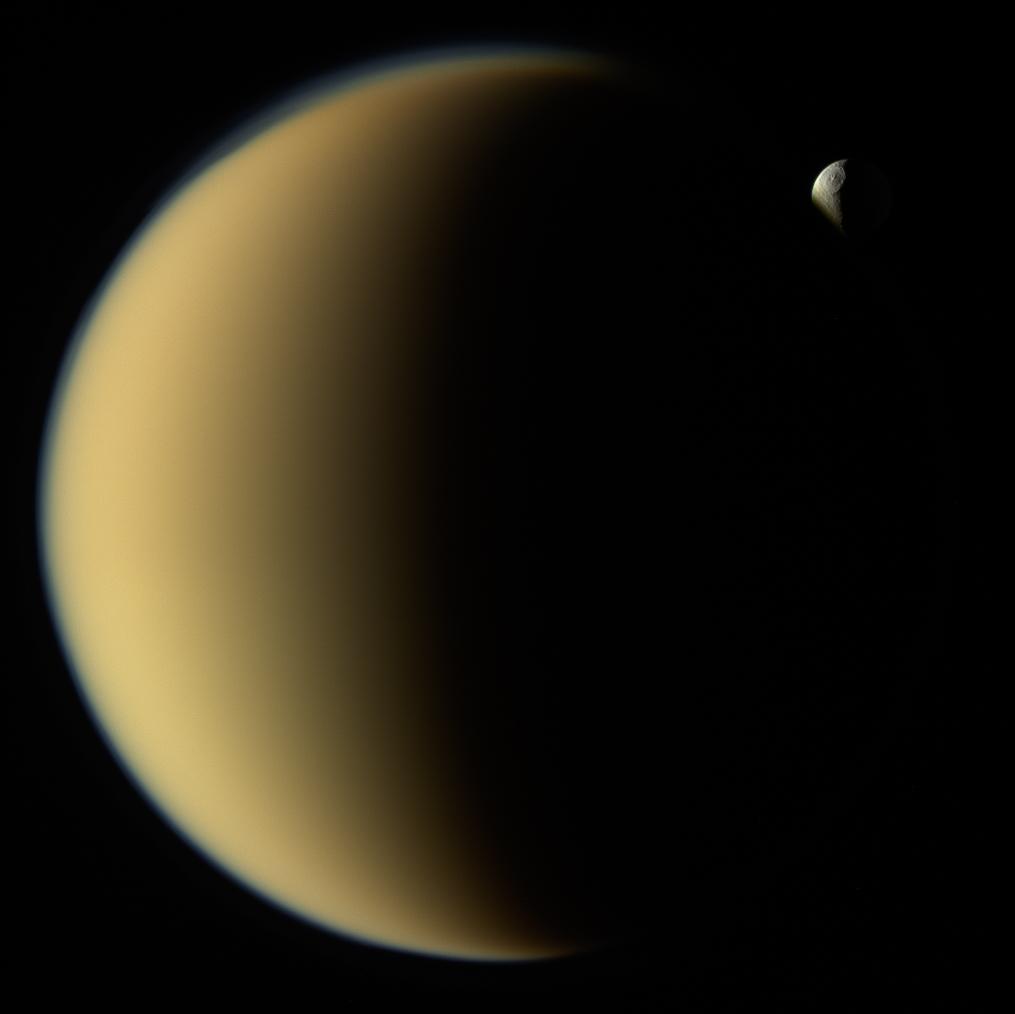Two for One: Saturn Moon Titan Dwarfs Tethys in Stunning Cassini Photo

Two of Saturn's many moons take center stage in a gorgeous photo by NASA's Cassini spacecraft.
The icy satellite Tethys peeks over the shoulder of the huge and hazy Titan in the newly released natural-color image, which Cassini captured in November 2009. The probe was about 620,000 miles (1 million kilometers) from Titan at the time, NASA officials said.
The 3,200-mile-wide (5,150 km) Titan is the second-largest moon in the solar system, trailing only the Jupiter satellite Ganymede. As the image shows, Titan has an extremely thick atmosphere that obscures views of the moon's frigid surface in visible light. But radar data gathered by Cassini over the years has revealed this complex and otherworldly surface in detail, showing that Titan harbors lakes and seas of liquid hydrocarbons, among many other intriguing features. [In Photos: Cassini's Epic Dive Into Saturn]
With a diameter of about 660 miles (1,070 km), gray and battered Tethys is Saturn's fifth-largest moon. Tethys also has a diverse surface, with a big impact basin and an enormous trench that wraps around nearly three-quarters of the moon's circumference. And heat maps based on Cassini thermal data revealed a weird shape that looks a lot like Pac-Man for some reason. (Fellow Saturn moon Mimas also sports a similar thermal feature.)
The $3.9 billion Cassini mission launched in October 1997 and arrived in the Saturn system in the summer of 2004. The Cassini orbiter also deployed a European lander called Huygens, which descended to Titan's surface in January 2005.
Cassini explored the Saturn system for more than 13 years, making a variety of intriguing discoveries — those hydrocarbon seas on Titan, for instance, and geysers blasting from the south polar region of the icy moon Enceladus. Cassini's observations further revealed that the water in those geysers is coming from a buried ocean, which may be capable of supporting life as we know it.
Cassini began running very low on fuel last year, so the spacecraft's handlers steered it to a plunge into Saturn's atmosphere on Sept. 15, 2017. Mission team members wanted to ensure that the orbiter never contaminated Titan or Enceladus with microbes from Earth.
Get the Space.com Newsletter
Breaking space news, the latest updates on rocket launches, skywatching events and more!
Follow Mike Wall on Twitter @michaeldwall and Google+. Follow us @Spacedotcom, Facebook or Google+. Originally published on Space.com.
Join our Space Forums to keep talking space on the latest missions, night sky and more! And if you have a news tip, correction or comment, let us know at: community@space.com.

Michael Wall is a Senior Space Writer with Space.com and joined the team in 2010. He primarily covers exoplanets, spaceflight and military space, but has been known to dabble in the space art beat. His book about the search for alien life, "Out There," was published on Nov. 13, 2018. Before becoming a science writer, Michael worked as a herpetologist and wildlife biologist. He has a Ph.D. in evolutionary biology from the University of Sydney, Australia, a bachelor's degree from the University of Arizona, and a graduate certificate in science writing from the University of California, Santa Cruz. To find out what his latest project is, you can follow Michael on Twitter.









